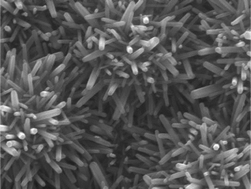Urchin-like nanowire array: a strategy for high-performance ZnO-based electrode utilized in photoelectrochemistry†
Abstract
The electrodes in photoelectrochemical cells responsible for the generation of hydrogen and oxygen by

* Corresponding authors
a
Department of Materials Science and Engineering, Chungnam National University, Daejeon, Rep. of Korea
E-mail:
dojin@cnu.ac.kr
Fax: +82 42 823 7648
Tel: +82 42 821 6639
The electrodes in photoelectrochemical cells responsible for the generation of hydrogen and oxygen by

 Please wait while we load your content...
Something went wrong. Try again?
Please wait while we load your content...
Something went wrong. Try again?
H. N. Hieu, N. Q. Dung, J. Kim and D. Kim, Nanoscale, 2013, 5, 5530 DOI: 10.1039/C3NR00889D
To request permission to reproduce material from this article, please go to the Copyright Clearance Center request page.
If you are an author contributing to an RSC publication, you do not need to request permission provided correct acknowledgement is given.
If you are the author of this article, you do not need to request permission to reproduce figures and diagrams provided correct acknowledgement is given. If you want to reproduce the whole article in a third-party publication (excluding your thesis/dissertation for which permission is not required) please go to the Copyright Clearance Center request page.
Read more about how to correctly acknowledge RSC content.
 Fetching data from CrossRef.
Fetching data from CrossRef.
This may take some time to load.
Loading related content
